Trade shows and branding are like peanut butter and jelly. It’s the perfect combination. As a marketer, you want to maximize the impact of your brand in a show hall overflowing with logos, messaging, and clever graphics.
However, there’s no one ideal solution that fits every company, every show, and every situation. That’s one of the reasons trade show marketing can be both challenging and fun. It defies “plug and play” answers that work well for print or digital marketing, but fall flat in an exhibition hall filled with hundreds of other exhibitors. Trade shows force you to be nimble, strategic, and at the top of your game at every trade show. There will always be winners and losers on the show floor, but with a little assistance from an experienced professional, you can significantly increase your odds of success. We’re here to give you that “leg up.”
Introduction: Brand Identity Meets Trade Shows
Brand, Branding, and Brand Identity are common marketing terms, tossed around like candy at a 4th of July parade. Let’s start by defining each one and explaining how they differ from one another.
Brand refers to the overall perception of a company or product in the minds of consumers. It is the sum of all the experiences that consumers have with the brand, from the products or services they use to the marketing and advertising they see.
Branding is the process of creating and managing a brand. It involves developing a brand identity and then using that identity to communicate with consumers and build brand awareness. Branding can take place through a variety of channels, including marketing, advertising, public relations, trade shows, and social media.
Brand Identity is the collection of tangible brand elements that together create one brand image. This includes the brand name, logo, colors, typography, imagery, and tone of voice. Brand identity is what consumers can see, hear, touch, and feel, and it plays an important role in shaping their perception of the brand.
Trade shows, unlike other forms of marketing, are immersive, intensive, and collective. Think of all the discrete ways your company communicates your brand identity – print, digital, events, social media, and face-to-face. All that branding happens simultaneously at a trade show. It’s both the superhighway and the intersection of your branding, And it’s not just what happens on the show floor. Your messaging starts weeks, often months, in your pre-show marketing. It happens during social events, educational sessions, and meetings on and off the floor. And even after the trade show when you engage potential clients, you’ve met during the show.
The Evolution of Brand Development in Trade Shows
Trade shows, or trade fairs, have a long and rich history dating back 1000s of years. The earliest trade shows were simple gatherings of merchants and artisans who came together to sell and trade goods. These early trade shows were often held in conjunction with religious festivals or fairs.
In the 18th Century, trade shows began to evolve into more specialized events. This was due to the Industrial Revolution, which led to the development of new products and technologies. Trade shows provided a platform for these new products to be introduced to the market.
The 19th Century saw the rise of international trade shows. The first World’s Fair was held in London in 1851 and attracted over six million visitors and showcased products and technologies from around the world.
The 20th Century saw the continued growth of the trade show industry. Trade shows became more sophisticated and professional events. They also became more specialized, with each industry having its own trade shows.
Today, trade shows generate billions of dollars in revenue each year and employ millions of people. Trade shows are an important way for businesses to connect with potential customers, launch new products, and stay up-to-date on the latest industry trends.
More recently, trade shows have embraced experiential marketing. Experiential marketing engages consumers through memorable and meaningful experiences. It often involves creating events or environments that allow consumers to interact with a brand in a hands-on way.
For example:
- Product demonstrations or tastings
- Interactive exhibits or displays
- Pop-up shops or showrooms
- Contests or giveaways
- Live music or entertainment
The goal of experiential marketing is to create a lasting positive impression that will make consumers more likely to remember and purchase from a brand. More and more companies are embracing experiential marketing as an essential component of their trade show and event marketing. To be successful requires strategy, planning, and execution. In other words, significant effort, one that not all legacy exhibitors have embraced.
The Role of Branding Signage in Trade Show Booths
Trade shows are a vast sea of colorful signage vying for the attendees’ attention on every aisle, every turn, and even above the show floor. Add to the mix the proliferation of backlit graphics and now LED video tiles and it’s a competition on visual hyperdrive. How does the smaller island let alone the average catch an exhibitor’s attention?
Brand Identity
Brands like Coca-Cola and IBM have spent billions of dollars searing their logos into our brains. However, every trade show is a subgroup of trades, professions, and interests with familiar companies to that audience. SmileCon, a trade for the dental profession, has brands only dental professionals know. At that show, there are multiple dental “Coca-Colas” that have a recognizable brand identity to the dental community.
Professional Exhibit and Graphic Design
Exhibit designers and 3D graphic designers are specialists. They understand the power and nuances of 3D structures as a medium for trade show marketing and messaging. Even if you already have a graphic designer who understands your brand identity, you would be wise to consult with a 3D graphic designer. They’ll be able to guide your graphic designer on how to maximize your visibility on the show floor.
Relatable Theme & Engaging Story
Trade shows are unlike any other marketing medium. Exhibitors have the freedom to create themes specific to their company, products, and events which would be impractical otherwise. For example, a show in New Orleans may inspire you to tap into the Louisiana Creole culture for graphics or in-booth experiences. Along the same lines, your company may have a unique story to tell which would be challenging via traditional marketing. The key is to make that story relatable and memorable to your audience. How does it connect them to your products, services, and brand?
Problem/Solution
All too often, marketers assume both the problem they address and the solution they’re solving is obvious. It’s not. In the hustle and bustle of a trade show, exhibitors have only a few seconds to communicate to attendees their value as a potential resource. Communicating what you do isn’t enough, whether you’re an aftermarket auto parts supplier, a CRM software company, or an expert on sourcing manufacturing in Asia. The next time you’re at a large trade show take a few minutes to study the hanging signs. Most start and stop with basic branding. However, the really effective ones tell you at a glance the problem they solve – succinctly and occasionally with a clever twist that compels you to investigate.
Visual Identity: 5 Examples from the Trade Show Floor
1. AnHeart
In this 20 x 20 island exhibit, the distinctive logo has prominent placement on every side and at multiple heights of the booth. In addition, the product descriptions are short and along the aisle and include QR codes for more information. The enclosed conference room, along with the reception counter and waiting area, communicate the importance of face-to-face discussions with clients.
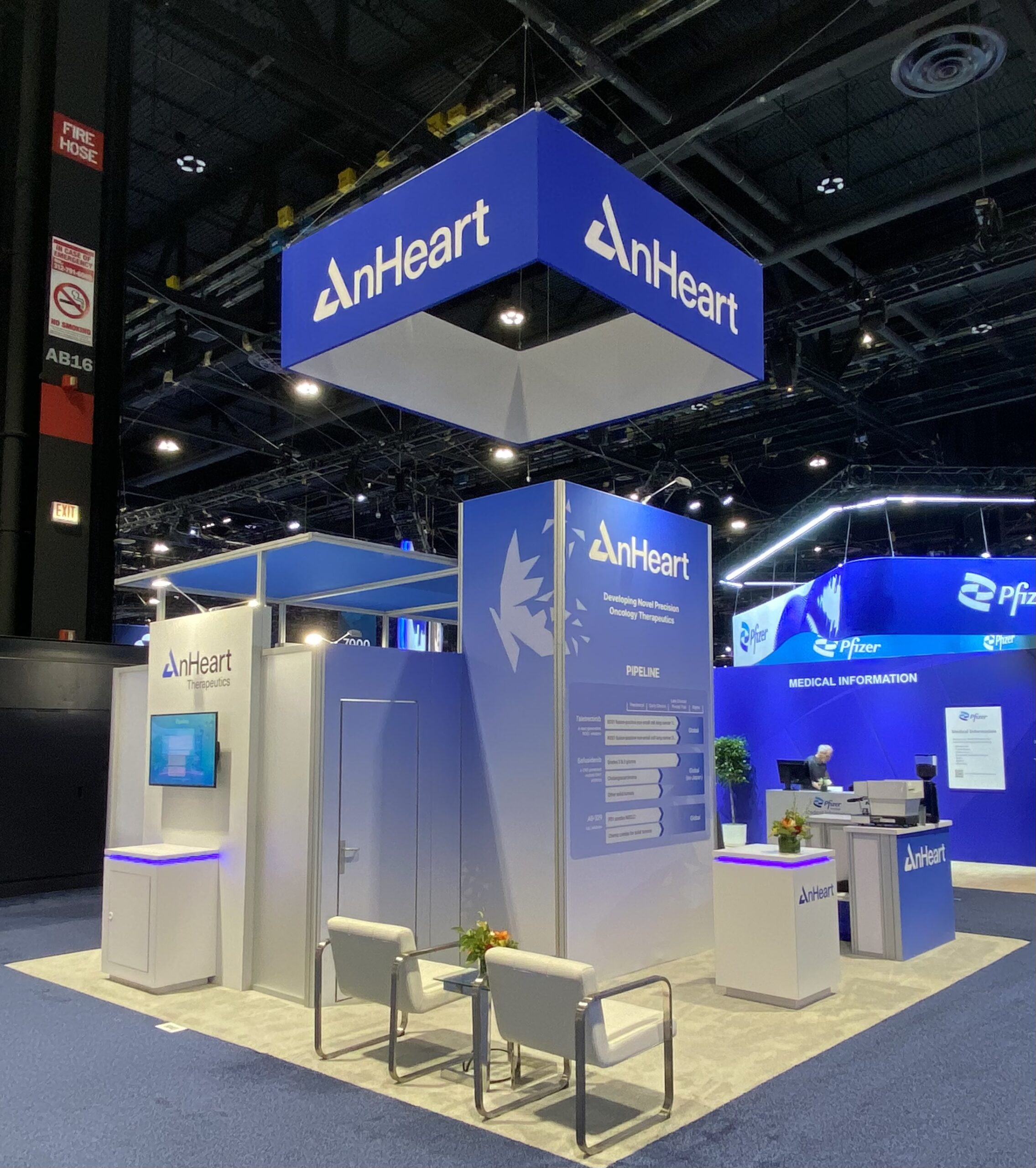
2. Slate
This unmistakable island exhibit feels open and inviting, not only because of the multiple entrances into the booth but also because of the impressive large format graphics of mountains, lakes, and trees.
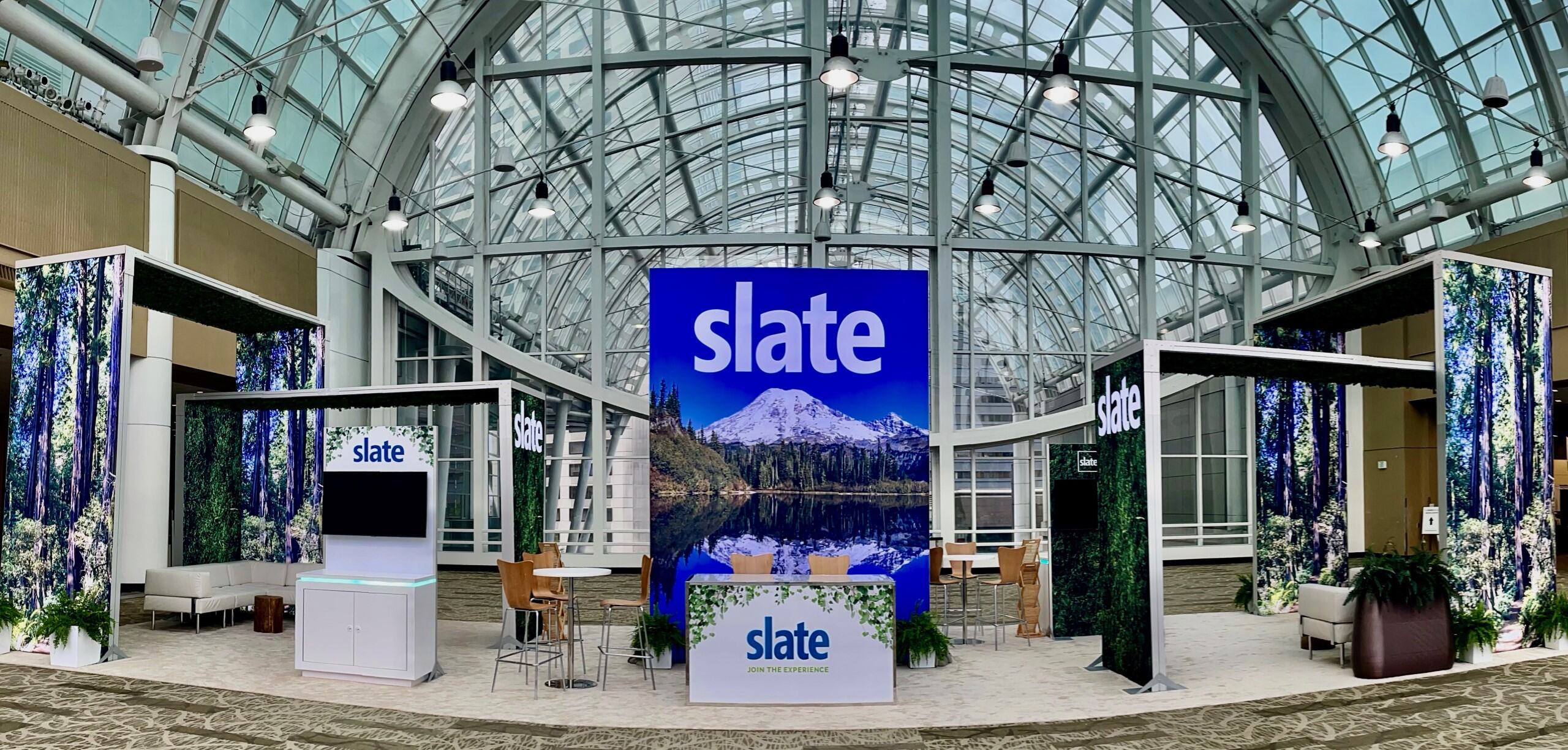
3. Roquette
This open island design encourages casual conversation with both table and soft seating options. The graphics serve as a visual and educational backdrop for the company’s products/services.
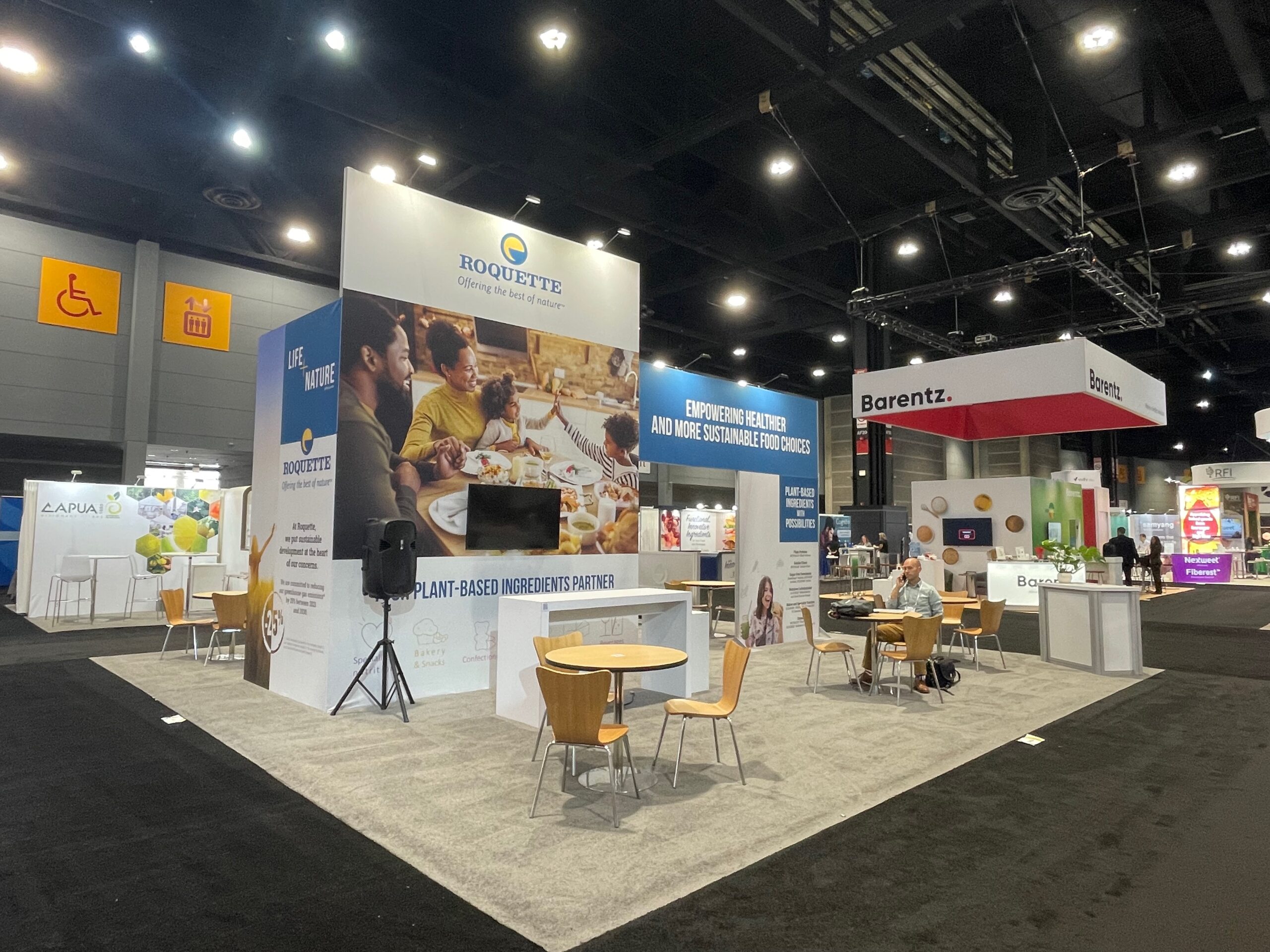
4. Bamboo Health
This upscale yet straightforward inline exhibit rejects clutter for clear messaging and branding which is backlit for greater visibility.
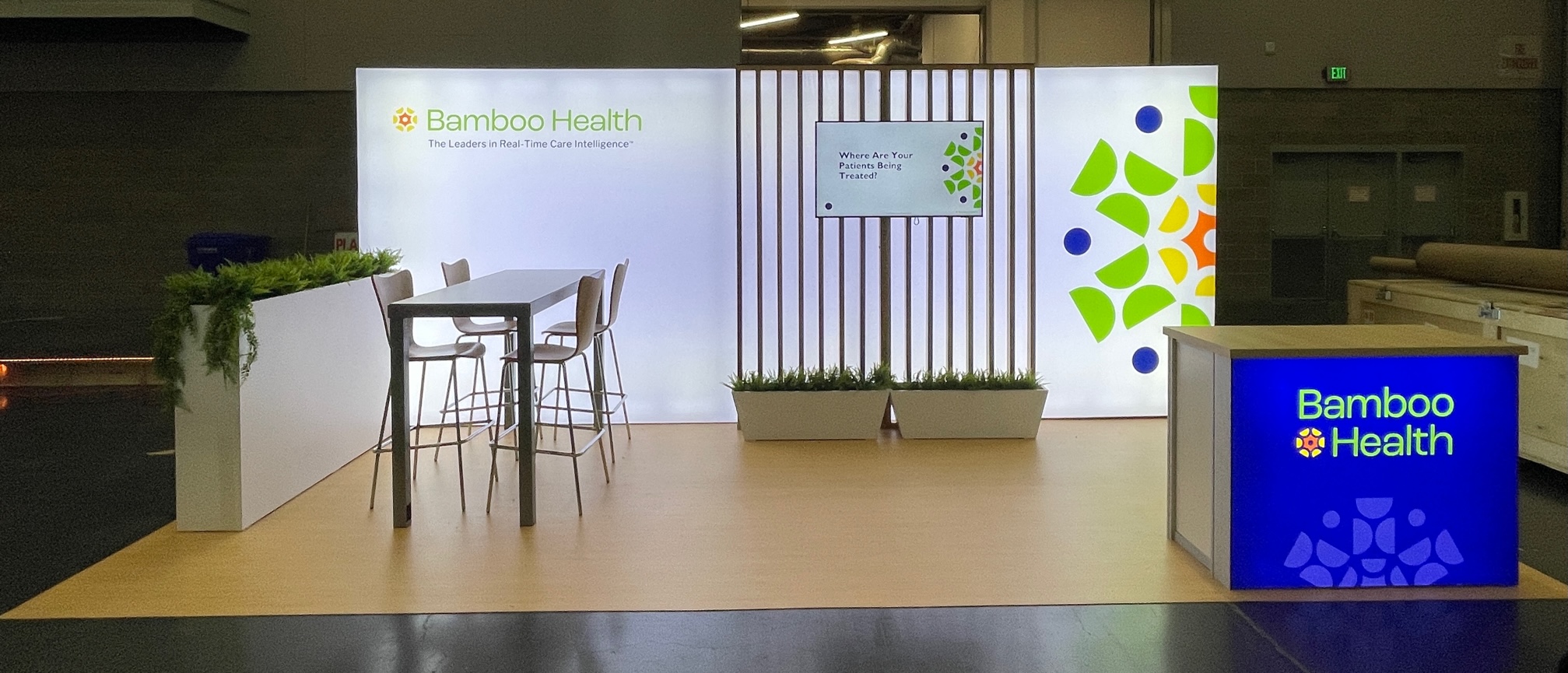
5. Gelita
Double-deck booths offer greater opportunities for branding and distinct meeting spaces. The large format graphics along the aisle allow the exhibitor to tell their story without adding visual clutter to the messaging.
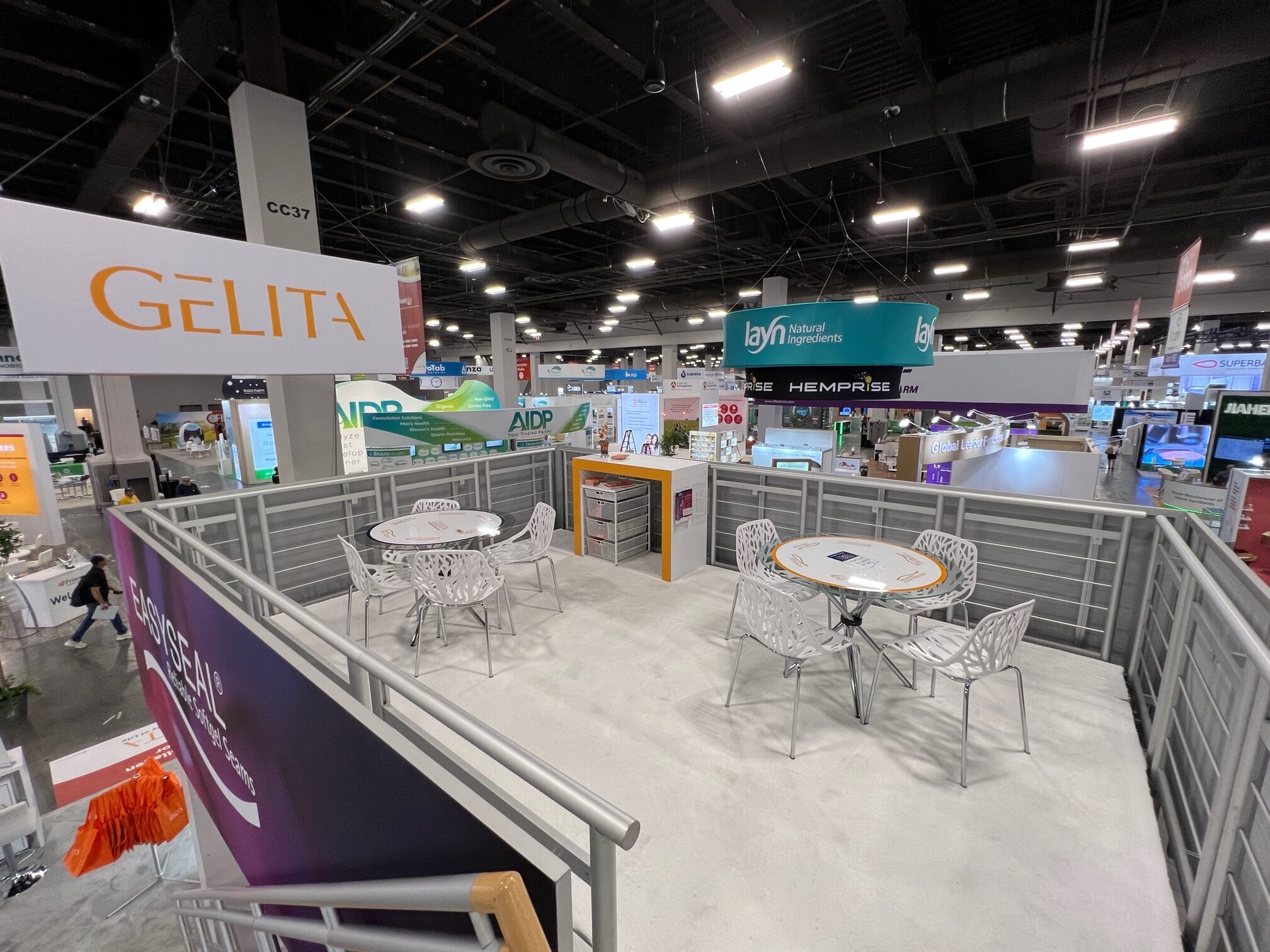
Brand Personality: Tips for Engaging and Connecting with Attendees
You know your company and brand personality. You know your customers. So, how do you create a memorable experience that builds on both while staying true to your branding and your trade show goals? That’s the challenge trade show marketers face all the time.
Creating meaningful and memorable connections requires approaching trade shows less as an exhibition with hundreds of competing exhibitors and more like a private event organized by your team. While a trade show is not a private event, that mental shift matters. You are now responsible for inviting guests to your booth (instead of simply attracting them from the show floor), creating an agenda, arranging for entertainment (or experiences), and interacting with them as guests, not simply as random visitors.
By controlling the experience, at least within your booth space, instead of allowing the show organizer to control it, you take charge of your success and how you measure that success. It’s their show, but it’s your event. One of the most effective ways to engage your guests is via interactive experiences or experiential marketing.
Experiential trade show marketing is a strategy for creating memorable brand experiences and generating leads. By engaging attendees in interactive and immersive experiences, you can differentiate your brand from the competition and make a lasting impression. Here are some experiential trade show marketing ideas:
1. Create a Sensory Experience
Engage the senses with touch, sight, sound, smell, and taste. For example, if you sell furniture, let people try out your products in a comfortable setting. If you sell software, create a virtual reality demo that allows people to experience your product firsthand. And if you sell food or beverages, offer samples for people to try.
2. Gamify Your Booth
Incorporate games and challenges into your booth design. This is a great way to get people engaged and interacting with your brand. For example, you could create a trivia game about your products or services, or have a contest where people can win prizes for completing a challenge.
3. Host a Live Demonstration or Workshop
Show attendees how your product or service works. This is a great way to educate potential customers and showcase your expertise. You could also offer hands-on workshops where people can learn how to use your product or service for themselves.
4. Use Technology to Create Interactive Experiences
Leverage technology to create immersive and engaging experiences. For example, you could use virtual reality, augmented reality, or interactive touchscreens to bring your brand to life.
5. Make It Personal
Personalize the experience for each attendee. This could involve using data to tailor your interactions to their interests or offering customized product recommendations.
6. Use Social Media to Attract and Feature Attendees
Encourage attendees to share their experiences on social media while also sharing their interactions in the booth on your social media. This is a great way to generate buzz around your brand and reach a wider audience. You could offer prizes for social media shares, or create a hashtag for the event.
Strategizing for Success: Trade Show Brand Strategy
Every successful trade show starts with a comprehensive strategy that has measurable quantitative or qualitative metrics. For example, increasing sales over X months counts as a goal, but not as a strategy. A strategy is a high-level plan to achieve one or more goals under conditions of uncertainty. It is a set of decisions that helps an organization define its direction and achieve its objectives.
Having a clear brand identity makes this process somewhat easier since you already know who you are. If your potential audience recognizes your brand identity, then it serves as a convenient shortcut to communicating and achieving your goals. If not, then the brand messaging must do more of the heavy lifting by both creating the identity and identifying an outcome for your audience.
So, knowing this, what are the most common intentional or unintentional branding strategies at trade shows?
- Staying on Brand. Exhibitors create structures, graphics, demos, activities, and sales presentations that match their brand identity.
- Changing the Brand. For some companies, a trade show represents an excellent venue to launch new or modified branding. Not only is there a large audience who will see the change but the face-to-face nature of a trade show allows them to explain it to their audience.
- Ignoring the Brand. This can be a conscious, deliberate decision to subvert the expectations of their target audience. More often it’s an unintended consequence of either not fully understanding their branding identity or allowing a non-strategic goal, graphics, or financial decision to dictate the branding.
Conclusion: The Future of Brand Identity in Trade Shows
No sales environment is as hyper-competitive as a trade show. It requires a clear strategy and careful execution. At Exhibits Northwest, we specialize in crafting tailor-made, branded trade show exhibits that perfectly represent your brand and identity.
With over three decades of experience and a track record of thousands of successful custom projects, we know just how to make your custom trade show booth stand out from the crowd and attract attention. Our team of expert designers and fabricators will leverage the latest technology and materials to ensure every detail of your trade show display is on-brand, from the layout and foundation to the graphics and finishing touches.
Experience the Exhibits Northwest difference today!
